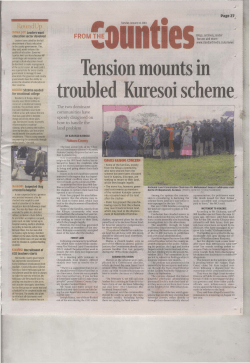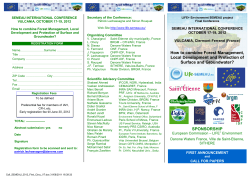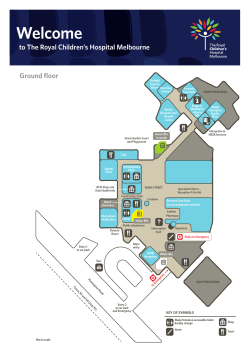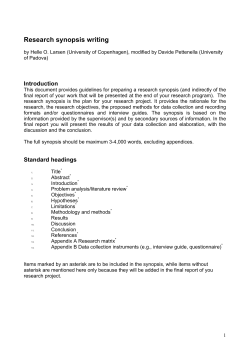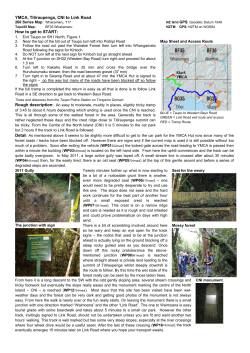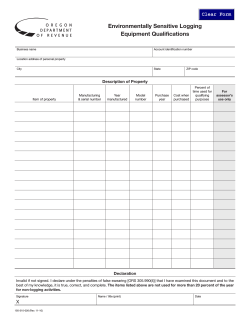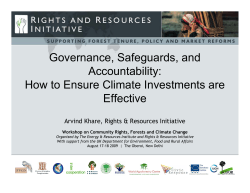
REPORT TO NEFA ON LANDOWNER EDUCATION INITIATIVES:
REPORT TO NEFA ON LANDOWNER EDUCATION INITIATIVES: How to effectively deliver forest stewardship information and knowledge to private forestland owners in the NEFA region Christina Petersen March 2006 EXECUTIVE SUMMARY A literature search and survey methods were employed to determine the most effective way to deliver stewardship information to private forest landowners in New York, Vermont, New Hampshire, and Maine. Much of the literature details studies which examine the methods of communication landowners prefer, but few analyze whether the communication effectively changes behavior. Evaluations of programs conducted by NEFA state staff mostly focus on the utility of the program, rather than whether the program changed the behavior of the participant. The most relevant observation from both looking at the literature and interviewing experts is that no one system of communication fits all types of landowner. Delivery systems should be adapted to fit the characteristics of the intended audience, and educators should periodically survey clientele to determine demographic change. The literature and the interviews indicate that educators should adopt efficient technologies for communication, but should not abandon more traditional methods until it is warranted by lack of demand. Forest landowners still seem to prefer written communication above all other forms, but a combination of print and Web works well for younger audiences. At least one regional expert questions the premise that forest landowners want to take any kind of course that will help them to “get” what they want from their land. If what they want is peace, solitude, and a relationship with nature, will these benefits really improve by taking a course? This paradigm shift is present in the literature as well. INTRODUCTION Delivering information on forest stewardship to non-industrial private forest landowners in an effective manner is a primary mission of state natural resource agencies. Private and public funds are directed toward education, technical assistance, cost-sharing for management activities, preferential tax treatment linked to appropriate management, conservation easements, various management organizations, and, more recently, green certification. While each program has been successful in reaching some landowners in the NEFA states, and numbers of participants have grown in recent years (table 1) many do not take advantage of existing opportunities. Table 1. Acres of Non-Industrial Private Forest Lands Enrolled in the Stewardship Incentive Program, 1997 and 2003 (thousands of acres) NIPF lands Maine New Hampshire New York Vermont 8,353 3,370 NIPF lands enrolled in SIP,1997 161 269 % of NIPF lands enrolled in SIP, 1997 2% 8% NIPF lands enrolled in SIP, 2003 573 527 % of NIPF lands enrolled in SIP, 2003 7% 16% 13,687 3,653 807 173 6% 5% 1,539 293 11% 8% From NFLC at Ten Years: The Background Paper, NEFA, 2004 Report to NEFA on Landowner Education Initiatives March 2006 Final Report Why do such a small percentage of NIPF’s participate in the Stewardship Program? Are communication methods used to get the word out at fault? What methods, both regionally and nationally, have been the most successful in communicating forest stewardship information to forest landowners? METHODOLOGY A literature review of publications and reports relevant to private forestland owner outreach practices was conducted, using the University of MA, Amherst, library and the Internet. NEFA contributed names and contact information for staff that have many decades worth of experience in this work in each NEFA state. Recognized regional and national experts in private forestland owner outreach were also identified. These individuals were sent an email questionnaire or were interviewed over the phone. Please see Appendix A for the names of these individuals. DISCUSSION What is the "gold standard" in effective delivery of forest stewardship information and knowledge to private forestland owners in the NEFA region? How should the NEFA states focus their resources in order to reach landowners? Should programs try to reach the most people, or the most acres? What outreach methods are the most effective: traditional workshops, print materials, interactive video, CDROM, Web based education, other? Cooperative Extension has been developing and delivering outreach programs to agricultural and forest landowners for over 100 years, and state natural resource agencies have been involved in landowner education for at least 50 years. A review of the literature, and interviews with experts’ show that these groups struggle constantly with what method of outreach is the most effective. Extension staff has collaborated with faculty at numerous land grant colleges in studying this issue, and some of these studies are summarized below. Many studies examine which methods of communication landowners prefer. Few analyze whether the communication effectively changes behavior. A review of the literature J. G. Richardson from North Carolina Cooperative Extension Service did an extensive study on program delivery methods in Extension education (Richardson 2001) and classified educational delivery methods into three groups: experiential, reinforcement, and integrative. According to Richardson, to promote effective and efficient learning, a delivery system should include methods wherever possible that provide desired experiential opportunities for the learner, reinforce the learning, and provide opportunity for the learner to integrate new information with existing knowledge and skills. Further, Richardson identified several factors that should be considered in the delivery of educational information: • Target audience, • Educational objective, • Type and content of message being provided, • Characteristics of the delivery method, and • The method's utility for providing desired learning support. All studies cited below included these factors in the planning and analysis of the programs. Studies concerning the preferred means of learning 1. The Green Valley Institute (GVI) is an educational partnership program among the University of CT and MA Cooperative Extension System and the Quinebaug-Shetucket National Heritage Corridor. A needs assessment survey conducted in 2001 indicated that the preferred means of learning about land use 2 Report to NEFA on Landowner Education Initiatives March 2006 Final Report planning and/or sustainable economic development issues were publications, workshops, Web site, video, email, and phone. In 2003 GVI conducted a study looking at the effectiveness of a CD-ROM direct mail effort linking viewers with a Web site. Findings show that 60% of those who receive a CD in the mail viewed it at least moderately and as a result will: • • • • Have greater familiarity with the organization's goals, View the Web site more, Think the Web site is more useful, and Have greater intentions to contact the organization for additional information/assistance in the future. The study also showed that lack of computer equipment was not an impediment to this audience, but that they still prefer more traditional Extension learning channels (e.g., publications and workshops), though Web -based communication is not far behind in terms of preference. Researchers also found out that many CD’s were probably disposed of as “junk mail” before viewing. Forty percent of the CD recipients in this study stated they viewed it slightly or not at all, and when a sample of these individuals were asked, 22% said they could not remember receiving the CD in the mail. 2. Howell et al (2001) examined the communication preferences of 922 agricultural landowners in Michigan. Participants were asked to report demographic information such as age, education level, income, farm operation, farming status, and farm size. Respondents also identified how often they participated in Extension programs and which communication strategies they preferred to learn about watershed conservation issues. In addition, respondents provided information about their Internet access location and how often they use the Internet for management decisions. Overall, survey respondents preferred traditional written communication strategies such as newsletters, printed bulletins, and fact sheets. Respondents expressed the least amount of preference for technological communication strategies such as computers, e-mail, and the Internet. There was a statistical difference between age groups and preference for written communication strategies, media, and computer or Internet methods of learning about watershed conservation issues. Younger, collegeeducated, and more affluent farmers have a higher preference for computer-based resources than older age groups, but still express a higher preference for more traditional or written communication strategies. 3. Researchers in West Virginia refined their outreach practices by canvassing landowners to find out what traditional assistance methods they prefer. These traditional methods that facilitate either education or direct application of forestry practices include financial assistance, workshops, and professional technical visits. During the winter of 1999-2000, questionnaires were sent to 1,080 private woodland owners in West Virginia In the analysis, survey respondents consistently indicated that they prefer "technical aid" to other methods of assistance. Averaging over the nine forestry topics analyzed, 68% of the landowners surveyed preferred technical assistance; 51% financial aid; and 53% wanted workshop training. 4. Results of the survey of 400 landowners indicate that private forest landowners within the natural range of longleaf pine in South Carolina are typically more than 45 years-old, either work in a recognized profession or are retired, are well educated, have above average income, and have individual ownership of their land. Seventy-seven percent of the respondents had received technical assistance from several sources including private consulting foresters, state foresters or wildlife biologists, industrial foresters, Extension Service, Natural Resources Conservation Service, Farm Service Agency, and others. The declining order of preference for communication was the following: newsletters, publications, field 3 Report to NEFA on Landowner Education Initiatives March 2006 Final Report tours, video, workshops, evening meetings, short courses, formal classes, and the Internet. The study did show that educators should be careful when attempting to reach elderly landowners with video and the Internet, and other technology-based delivery systems. Some innovative forms of outreach a. Using an interactive video short course The Extension program of the Department of Forestry at Mississippi State University evaluated forest landowners acceptance of an interactive video short course. This extension program has traditionally utilized field days, short courses, and other direct contact educational methods for instructing forest landowners but was interested in using new delivery techniques that also provide reduction in costs. An evaluation form was developed and given to all attendees. Participants who attended traditional forest landowner short courses in the past were asked to compare the interactive video short course with the traditional short course delivery method. The results of study indicate that the interactive video format can be used for future Extension forestry programming in Mississippi while maintaining the current client base. The interactive video format allows greater flexibility in scheduling short courses while increasing the efficiency of program delivery by reaching participants in several counties at once with minimal travel costs. Interactive video also provides a format for single-night programs for participants unwilling to commit to a multi-session program, a way to provide information in the event of catastrophic damage, and to utilize experts who may not want to commit to a multi-session program. However, technical difficulties experienced with interactive video and other distance learning programs can reduce their effectiveness and impact. b. Reaching “underserved” forest landowners Extension staff, landowner organizations, and state DNR’s in Arkansas, Louisiana, Mississippi, and Tennessee collaborated in 2003 to design workshops for “underserved” landowners, defined as minorities, females, and other landowners not generally served by current federal, state, and local programs. Underserved forest landowner workshops conducted in the south-central U.S. consistently attract larger numbers of participants than more traditional Extension forestry programs. Landowner evaluations revealed that the primary way landowners learned about the workshop was through a letter sent through the mail. Landowner databases were developed from tax roll information, and letters were mailed to landowners with 10 or more acres of forestland. Local planning committees helped plan, promote, and conduct the workshop. Workshop attendance was directly related to the number of landowner letters mailed. Evaluations indicated that landowners valued the information received and anticipated greater monetary returns because of the workshop information. c. The Welcome Wagon Ohio State University Extension and Rural Action Sustainable Forestry initiated a joint effort with the objective of providing new woodland owners in Appalachian Ohio with the contacts and information needed to help them make informed decisions about the management of their forest resources. They termed it a “Welcome Wagon” approach. The initial mailing included a welcome and an invitation to pick up a resource packet at the County Extension Office. A second mailing included more descriptive information about the effort, a contact sheet listing local assistance providers, and the invitation. Thirty of the 545 landowners who were mailed invitations requested or picked up the packet. Response rates ranged from 2.8% to 8.9%, with an overall response rate of 5.5%. Based on the results of this pilot project, the following modifications will be implemented to improve the potential success of an expanded project: 4 Report to NEFA on Landowner Education Initiatives Final Report March 2006 • Frequently use a multi-media approach to reach new and tenured landowners, • Include contact information for local assistance providers with all mailings, • Encourage other organizations and agencies to collaborate, • Send at least three mailings within the first two years of ownership, • Secure additional incentives to encourage participation, • Develop a Web page as an additional method of information dissemination, • Offer targeted educational programming in Welcome Wagon counties, and • Use a follow-up survey to evaluate the process. Interviews with regional and national experts Interviews with regional and national experts, representing state DNR programs, non-profit landowner groups, and academic institutions indicate that few have actually conducted studies looking at the effectiveness of their programs. The following observations are mostly anecdotal. 1. Which outreach method do you think is most effective (drawing on your professional experience)? Conservation educators in the NEFA states agree that no one method of outreach is the most effective. A few emphasized that important questions need to be asked before a program is designed: who is the audience, what are your objectives for reaching them, what are the needs of the recipient- this will have an effect on the receptivity of the message. One educator emphasized that “People are not ready to hear our message until they are ready and we need to be ready when they are ready.” Effective outreach tools are important, but the real key is to “be visible and known as the credible place to turn when needed”. Most emphasize that one-on-one outreach is most effective both in terms of connecting with the landowner, and also for improving management, but recognize that it is not cost-efficient for the organizations or agencies. Traditional workshops were also indicated as effective. All educators recognized the value of print materials, but felt that a mix of print and Web were the most effective. Some utilized CD-ROM’s and traditional video, but noted that they were not convinced of their usefulness. Satellite conferencing or remote TV conferencing had been used, but technological mishaps discouraged users. Several educators emphasized the usefulness of the Coverts program, or volunteer training programs where landowners spend time together and get encouraged by what others are doing on their lands. Over the last five years the Maine Forest Service has worked with two professional marketing/media agencies promoting Project Canopy (Maine’s Community Forestry Program) and Be Woods Wise (the Stewardship Program). They utilized paid and earned media, email lists, participation in various public events, one-on-one communication, email lists, news stories, and other. I have a phone call scheduled with the person who ran this program on March 5: CP. 2 Have you conducted formal or informal studies regarding effectiveness? One respondent noted that she regularly evaluates the utility of workshops for attendees. These evaluations are more of formative nature i.e., they use the results to improve future offerings as opposed to assessing program impacts. Three programs had been formally evaluated. The state of Maine conducted a focus group on Project Canopy (will find out more on phone call) Most other respondents had evaluated the utility of workshops, but not undertaken any formal approach to studying the effectiveness of their outreach programs. 5 Report to NEFA on Landowner Education Initiatives March 2006 Final Report 3. What method of outreach do you currently emphasize? Individual woodlot visits, Coverts, Web and print combinations, workshops for high profile issues. 4. Do you change your outreach method depending on the demographics of the audience: if so, how? Methods and topics are changed to reflect the age and place of residence of the attendees. Web-based programs are geared towards younger and also absentee owners. Coverts tends to appeal to rural residents interested in volunteering, wildlife habitat, and community stewardship. New Hampshire has developed several curriculums that focus on specific groups: Women and the Woods (developed with the state of Maine) is aimed at women woodlot owners; the Backyard Tree Farm program is for the under-10 acre owner; safety materials are provided for Cambodian sawmill workers, French translation as needed for logger training workshops; people with special needs are accommodated; a policy is in place that no one is refused attendance at workshops for an inability to pay; and sensitivity to literacy levels in workshops and one-on-one contacts is undertaken. 5. Do you change your outreach method depending on the average size of the landholdings in the audience: if so, how? More time is spent with people who own larger landholdings than those with smaller. Staff is more likely to make a direct call to a large landowner, or use multiple techniques to reach them. One person said that most of these contacts are made by county foresters who know the large landowners and the best way to contact them, so they are one-on-one contacts. 6 Report to NEFA on Landowner Education Initiatives March 2006 Final Report Appendix A Experts contacted: This list is not complete yet. I have calls into Doug Lantagne, Peter Smallidge, and Mary Jean Packer. Steve Anderson, Coordinator Massachusetts Forest Stewardship Program Ginger Anderson VT Department of Forest, Parks, and Recreation Gerald J Andritz NYS Department of Environmental Conservation Karen P. Bennett, Extension Professor, Forest Resources UNH Cooperative Extension Kevin D. Doran, Natural Science Educator Maine Forest Service Sam Jackson National Web-based Learning Center for Nonfederal Forest and Range Lands David B. Kittredge, CF, Professor and Extension Forester Department of Natural Resources Conservation University of Massachusetts - Amherst Susannah McCandless Vermont Family Forests Dave McGill Forest Resources Extension Specialist, WVA University 7 Report to NEFA on Landowner Education Initiatives March 2006 Final Report Appendix B Literature reviewed Apsley, David, Scott Bagley, and David Samples 2005. Using a Welcome Wagon Approach to Reach Out to Woodland Owners in Appalachian Ohio. Journal of Extension February 2005 Volume 43 Number 1. http://www.joe.org/joe/2005february/iw4.shtml , 17994 bytes Finley, A.O. and D. B. Kittredge, Jr. (in process, Northern Journal of Applied Forestry). Thoreau, Muir, and Jane Doe: Different Types of Private Forest Owners Need Different Kinds of Management. Howell, Jennifer L., and Geoffrey B. Habron 2004. Agricultural Landowners' Lack of Preference for Internet Extension. Journal of Extension December 2004 Volume 42 Number 6 http://www.joe.org/joe/2004december/a7.shtml , 49917 bytes Hughes, Glenn, Marcus K. Measells, Stephen C. Grado, Michael A. Dunn, Joshua O. Idassi, Robert J. Zielinske 2005. Underserved Forest Landowner Workshops: Opportunities for Landowners and Extension Journal of Extension August 2005 Volume 43 Number 4 http://www.joe.org/joe/2005august/a5.shtml , 32132 bytes Londo, Andrew J., and Deborah A. Gaddis 2003. Evaluating Mississippi Non-Industrial Private Forest Landowners Acceptance of an Interactive Video Short Course. Journal of Extension October 2003 Volume 41 Number 5. http://www.joe.org/joe/2003october/rb4.shtml , 29341 bytes Magill, Daniel J. and Rory F. Fraser 2004. Refining Outreach to Woodland Owners in West Virginia-Preferred Topics and Assistance Methods Journal of Extension August 2004 Volume 42 Number 4 http://www.joe.org/joe/2004august/rb5.shtml , 28731 bytes Mater, Catherine M. (date?2001?) A 10-Point Guide to Reaching “Non-Joiner” NIPFs in the Eastern US. A report prepared for The Pinchot Institute for Land Conservation. Radhakrishna, Rama B., Larry Nelson, Robert Franklin, George Kessler 2003. Information Sources and Extension Delivery Methods Used by Private Longleaf Pine Landowners. Journal of Extension August 2003 Volume 41 Number 4 http://www.joe.org/joe/2003august/rb3.shtml , 35695 bytes Richardson, J. G. (2001). Extension education: Process and practice. . . Program delivery methods. North Carolina Cooperative Extension Service. Sagor, Eli 2005. Reaching Woodland Owners Online: Current approaches and recommended future directions for Minnesota. A report submitted to the Blandin Foundation. Westa, Susan P., Stephen H. Broderick, and C. Benjamin Tyson 2005. Getting the Word Out in the Last Green Valley: Integrating Digital Video, Direct Mail, and Web-Based Information for Specific Target Audiences. Journal of Extension August 2005 Volume 43 Number 4. http://www.joe.org/joe/2005february/a7.shtml , 27937 bytes 8
© Copyright 2025




